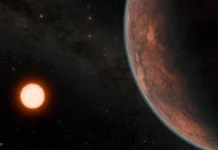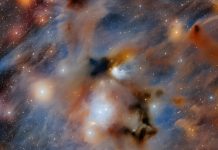
A new theory for how rocky planets form, developed by Caltech planetary scientist Konstantin Batygin and researcher Alessandro Morbidelli of the Observatoire de la Côte d’Azur, could explain the origin of so-called “super-Earths” — a class of exoplanets a few times more massive than Earth.
They’re the most abundant type of planet in the galaxy.
It could also explain why super-Earths in a single planetary system often wind up looking strangely similar in size, as though each system were capable of producing only a single kind of planet.
“As our observations of exoplanets have grown over the past decade, it has become clear that the standard theory of planet formation needs to be revised, starting with the fundamentals,” says Batygin.
“We need a theory that can explain the formation of the terrestrial planets in our solar system as well as the origins of self-similar systems of super-Earths, many of which appear rocky in composition.”
The work was supported in part by the U.S. National Science Foundation, and the resulting paper was published in Nature Astronomy.
In our solar system, there are two distinct types of planets: the smaller, rocky, inner planets closest to the sun; and the outer, larger, water- and hydrogen-rich gas giants farther from the sun.
This difference led Morbidelli, Batygin and colleagues to suggest that planet formation occurred in two distinct rings in the protoplanetary disk: an inner one where the small rocky planets formed; and an outer one for the more massive icy planets — two of which, Jupiter and Saturn, later grew into gas giants.
But what single process could have given rise to the rocky planets in our solar system and to uniform systems of rocky super-Earths?
In a paper published in 2020, Batygin and Morbidelli proposed a theory suggesting that bodies would grow in the ring until becoming large enough to exit the ring. At that point, they stop growing, which explains why the process produces bodies of similar sizes.
In their new paper, Batygin and Morbidelli suggest that the mechanism for forming planets around stars is largely the same.
The new theory identifies a “planet factory” ring as the likely site that, over time, can produce several similarly sized rocky planets. As planets grow sufficiently massive, their interactions with the disk tend to draw these worlds inward, closer to the star.
The theory is supported by extensive computer modeling, but it began with a simple question. “We looked at the existing model of planet formation, knowing that it does not reproduce what we see, and asked, ‘What assertion are we taking for granted?'” Batygin says. “The trick is to look at something that everybody takes to be true but for no good reason.”
In this case, the assumption was that solid material is dispersed throughout the protoplanetary disks. By jettisoning that assumption and instead supposing that the first solid bodies form in rings, the new theory can explain different types of planetary systems with a unified framework, Batygin says.
Adds Martin Still, a program director in NSF’s Division of Astronomical Sciences, “These scientists’ development of new planet formation models is a wonderful example of the broad, cutting-edge research that NSF supports, investigating planetary formation, characterization and detection.”



